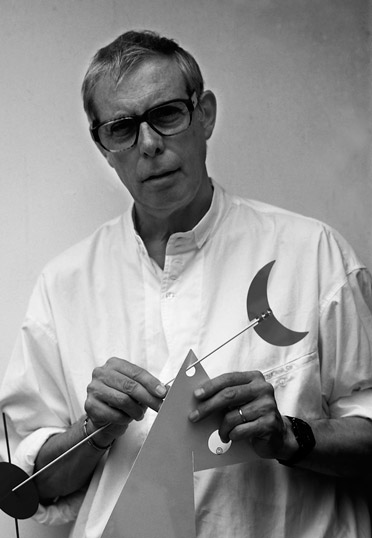
JOAN PEDRAGOSA DOMÈNECH (Badalona 1930, Barcelona 2005)
1947–50
Studied line drawing and industrial aesthetics in Barcelona with technologist Pere Casajoana.
1955
Worked as a draftsman in several Barcelona advertising agencies, particularly with advertising consultant Oleguer Jacas.
1959
Won the first prize in the poster contest of the Barcelona Trade Fair.
1960-62
Worked at the Consell de Publicité Ralph M. Chavannes, in Lausanne as head of the Projects and Graphic Creation Department.
1961
Met typographer Alfred Thuillard and worked with him. His great influence led to the creation of the Galaxy alphabet.
Together with other designers he founded the Graphic Artists’ Association FAD (Foment de les Arts Decoratives).
1962-64
Decided to settle in Barcelona and opened his studio in Tuset Street.
His stay in Switzerland signalled a rapid evolution based on pure geometric formalism. He became interested in Kasimir Malevich and Vladimir Tatlin’s Russian Constructivism and in the Western European avant-garde. He was deeply impressed by Swiss posters and Max Bill’s monumental geometry.
Creation of paraboloid modules for RIAM INTERNATIONAL in the 43ème Comptoir Suisse, in Lausanne.
He was particularly attracted to Italian Futurism, which evoked the sensation of speed and acceleration with its aggressive aesthetic expression.
In mid-1963 he began what was soon to become an exciting collaboration with Joaquín Gallardo, a well known interior designer. During this period Joan Perucho pointed out, in an article published in the magazine Destino, the influence that Joaquín Gallardo’s decoration had had during his “yellow” period with his decorative, pop design style.
In contrast there was Joan Pedragosa with his fiercely functional concept. At first sight this relationship seemed doomed to failure since not only did they have to work together in frank confrontation with a strict purity in the face of the polarizing power of hypnosis, but at the same time they had to offer, in terms of a preconceived goal, a product that had to be convincing in all its details.
This idea was put into practice in the creation of stands for the Barcelona Trade Fair. Scale models were made that proposed the use of absolute white in all their integrated
volume. Pedragosa was later to remember that more than once all the furniture was spray-painted white, producing a strong impression of dynamism and modernity. This formula continued to be used for almost three years.
1965
Separate of the collector’s volume ATZIMUT. Rapport Din. Machinations personnifiées. Sala Gaspar, Barcelona.
Appointed professor of advertising arts at the Municipal Conservatory of Sumptuary Arts of the Massana School.
Created the poster for the 4th International Joan Miró Award for Drawing.
1967
Taught methods for making and understanding volume in packaging at the Elisava School.
1968
Won the packaging design FAD Delta de Plata award for the packaging of a chemical product for SEIMEX laboratories.
1971
Created the poster and table-top display for the Barcelona General Assembly of VIVA AGI (Alliance Graphique International), of which he was a member.
1972
Creation and execution in bronze of the ALMERIMAR nautical trophy.
1976
Corporeal symbol for Rosa Bisbe Art/Disseny.
1982-85
Experimented with the application of geometry to demarcate the interaction between volume and space and went deeper into the language of geometry, as, for example, in the three dimensional logotype for MÉTODO 3.
1986-91
Created various table-top sculptures with swinging movement and dismantlable structures in PVC. He applied criteria for volumetric resolution in several projects, such as the object book Les senyores-senyores els trien calbs, by Marta Pessarrodona.
1987
Designed and built a series of didactic structures related to the Copernican theory of heavenly bodies, as well as others inspired in the curving of the straight line, as a tribute to Albert Einstein among others. The materials used in both series were PVC and copper plating, and were created for Abitar Publishing.
1988-93
He constructed several large sculptures, notable among which are El astrólogo, Pasajero a Juneau and particularly Anatomic packs. These sculptures were done entirely in corrugated cardboard and were part of the exhibition 1950-2000. 5 graphic designers at Cajastur (Revillagigedo Palace, Gijón, 1996).
1989-90
Creation of his first travel sculpture.
1991-99
Designed a series of table-top sculptures called Geometría opcional. All of them showed a clearly constructivist tendency and were made with a variety of materials. Those most frequently used were sheets of PVC in basic colours, white, yellow, blue and red; fibreglass ribs of 2 and 3 mm in diameter; counterweight spheres and pedestal of beechwood, nylon thread and flexible silicone tubing and ink-stained ecological cardboard of 325 and 650 grams.
1992
Travelled to Alaska, taking his travel sculptures in his luggage.
1996
Travelled to southern Patagonia and Tierra de Fuego where he accidentally found some fascinating cobblestones polished by the tides on Bahía Inútil. Their great aesthetic value marked his definitive turn to solid sculpture.
1997
Met Pere Casanovas, a well-known sculptor, and the two began a period of close collaboration.
1998-01
Period of intense creative activity.
2002
Presentation of his sculpture work at the CAJASTUR Cultural Centre, LA GEOMETRÍA COMO SEDUCCIÓN, along with an extensive catalogue of his work. His sculptures were exhibited in Oviedo and the travelling exhibition was then taken to Mieres, Avilés and Gijón.
2003
His work was shown at the MADI Museum in Dallas and in travelling exhibitions in Naples and Caserta (Italy).
2004
LLUM A LES ARESTES, a sculpture exhibition at the Caixa Terrassa Foundation Cultural Centre.
2006
Anthological exhibition ESPAI SENSE LÍMITS at the Badalona Museum.